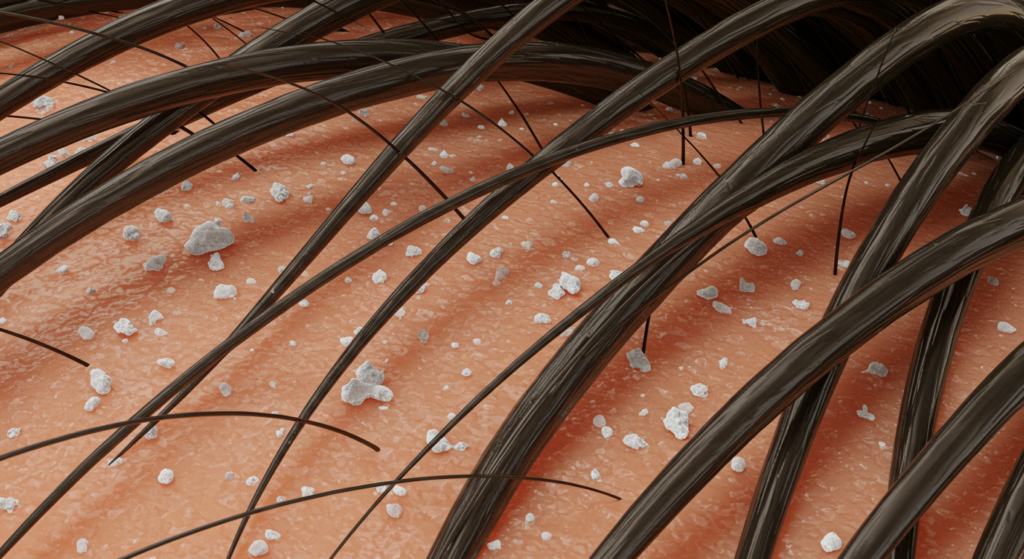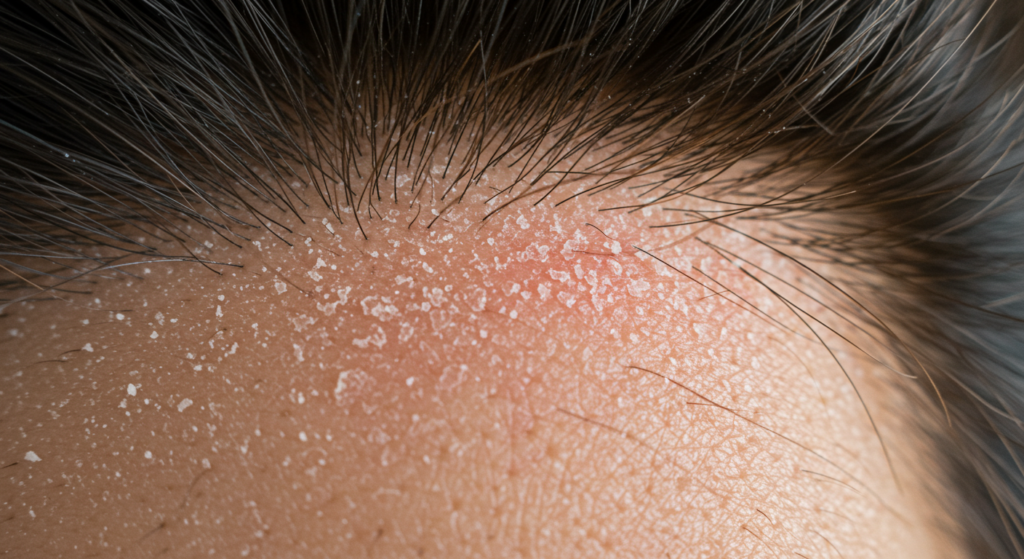La dermatitis seborreica es una afección cutánea común que afecta el cuero cabelludo, el rostro y otras zonas ricas en glándulas sebáceas. Se caracteriza por caspa, enrojecimiento y oleosidad, y puede variar desde una irritación leve hasta una molestia significativa. Comprender sus causas, síntomas y opciones de tratamiento es crucial para controlar esta afección eficazmente. Este artículo ofrece una visión general completa de la dermatitis seborreica, brindando a los lectores los conocimientos necesarios para controlar mejor sus síntomas y prevenir futuros brotes.

Comprensión de la dermatitis seborreica
La dermatitis seborreica es una afección cutánea inflamatoria crónica que se cree que se desencadena por una combinación de factores. Un factor clave es el crecimiento excesivo de... Malassezia Levadura, un hongo presente de forma natural en la piel. Esta levadura interactúa con la producción de sebo (grasa) de la piel, lo que provoca inflamación y los síntomas característicos. La predisposición genética juega un papel importante, ya que algunas personas son más susceptibles que otras.
Los factores ambientales también contribuyen a la dermatitis seborreica. El estrés, los cambios hormonales y ciertos medicamentos pueden exacerbar la afección. Los mecanismos exactos no se comprenden completamente, pero es evidente que una compleja interacción de factores genéticos, ambientales e inmunológicos impulsa el desarrollo y la progresión de esta afección cutánea. Comprender estos factores es vital para desarrollar un plan de tratamiento personalizado.
Además, la afección no es contagiosa. Si bien la levadura implicada está presente de forma natural en la piel de todos, es el crecimiento excesivo y la respuesta inflamatoria lo que causa los síntomas de la dermatitis seborreica. Esto la distingue de otras afecciones cutáneas que pueden transmitirse por contacto directo. Es importante diferenciar la dermatitis seborreica de otras afecciones con síntomas similares, como la psoriasis o el eccema, mediante un diagnóstico adecuado por parte de un profesional de la salud. dermatólogo.
Finalmente, la gravedad de la dermatitis seborreica puede variar considerablemente. Algunas personas solo experimentan caspa leve, mientras que otras sufren inflamación y descamación severas que pueden resultar bastante molestas. Esta variabilidad resalta la necesidad de tratamientos individualizados, adaptados a las necesidades y la gravedad de cada caso.
Síntomas comunes y su gravedad
El síntoma más común de la dermatitis seborreica es la caspa, que se caracteriza por la descamación del cuero cabelludo. Esta puede variar desde finas escamas apenas perceptibles hasta gruesas escamas amarillentas fácilmente visibles. El cuero cabelludo también puede presentar picazón e irritación, lo que provoca rascado y posibles infecciones secundarias. La gravedad de la caspa puede variar de leve a grave, afectando la comodidad y la autoestima de la persona.
Más allá del cuero cabelludo, la dermatitis seborreica puede afectar otras zonas ricas en glándulas sebáceas, como las cejas, los párpados, los laterales de la nariz y detrás de las orejas. En estas zonas, suele presentarse como manchas rojizas y escamosas, que pueden ser grasosas o aceitosas. Estas zonas también pueden presentar picazón e inflamación, lo que causa molestias y, en ocasiones, dolor.
La gravedad de los síntomas puede fluctuar con el tiempo. Los periodos de remisión, donde los síntomas son mínimos o inexistentes, pueden alternarse con brotes donde los síntomas son más pronunciados. El estrés, los cambios hormonales y las variaciones estacionales pueden desencadenar estos brotes. Reconocer estos desencadenantes puede ser útil para controlar la afección.
En casos graves, la dermatitis seborreica puede causar molestias significativas y afectar la calidad de vida. El intenso picor, la inflamación y la descamación antiestética pueden ser emocionalmente angustiantes e interferir con las actividades diarias. En estos casos, es fundamental buscar ayuda médica profesional para un tratamiento eficaz y el alivio de los síntomas.
Opciones de tratamiento eficaces disponibles
El tratamiento para la dermatitis seborreica busca reducir la inflamación, controlar el crecimiento excesivo de levaduras y aliviar los síntomas. Los champús antimicóticos de venta libre que contienen ketoconazol, sulfuro de selenio o piritionato de zinc suelen ser la primera línea de defensa. Estos champús ayudan a controlar la Malassezia La levadura reduce la descamación y la picazón. El uso constante es crucial para su eficacia.
En casos más graves, un dermatólogo puede recetar medicamentos antimicóticos más fuertes, como corticosteroides tópicos o inhibidores de la calcineurina. Los corticosteroides ayudan a reducir la inflamación, mientras que los inhibidores de la calcineurina ofrecen una alternativa menos potente con menos efectos secundarios. Estos medicamentos deben usarse según las indicaciones de un médico, ya que su uso prolongado puede tener efectos secundarios.
En algunos casos, pueden ser necesarios medicamentos antimicóticos orales, especialmente en casos generalizados o resistentes. Estos medicamentos suelen reservarse para situaciones en las que los tratamientos tópicos han resultado ineficaces. Un dermatólogo evaluará la condición del paciente y determinará el tratamiento más adecuado.
Además de la medicación, los cambios en el estilo de vida pueden desempeñar un papel importante en el manejo de la dermatitis seborreica. Mantener una buena higiene, evitar jabones y champús agresivos y controlar el estrés pueden contribuir al control de los síntomas. Una dieta saludable y un sueño adecuado también pueden favorecer la salud general de la piel y reducir la probabilidad de brotes.
Cómo prevenir futuros brotes
Mantener una buena higiene del cuero cabelludo es crucial para prevenir futuros brotes. Se recomienda una limpieza suave con un champú suave y sin perfume. Evite frotar con fuerza, ya que puede irritar el cuero cabelludo y agravar la inflamación. El lavado regular, generalmente cada dos días o según sea necesario, puede ayudar a controlar el crecimiento excesivo de hongos y prevenir la acumulación excesiva de sebo.
Las técnicas de manejo del estrés, como el yoga, la meditación o los ejercicios de respiración profunda, pueden ayudar a reducir la frecuencia y la gravedad de los brotes. El estrés es un desencadenante conocido de la dermatitis seborreica, y su manejo eficaz puede mejorar significativamente el control de los síntomas. Identificar y evitar los factores de estrés personales siempre que sea posible también es beneficioso.
Hidratar regularmente las zonas afectadas puede ayudar a prevenir la sequedad y el agrietamiento, que pueden agravar la inflamación. Usar una crema hidratante hipoalergénica y sin perfume puede ayudar a mantener la función barrera de la piel y reducir la irritación. También es recomendable evitar los productos químicos y las fragancias agresivas en el cuidado de la piel.
Finalmente, es fundamental mantener un estilo de vida saludable. Una dieta equilibrada, rica en frutas, verduras y cereales integrales, favorece la salud general de la piel. Dormir lo suficiente y controlar el estrés también son cruciales para prevenir los brotes. Las visitas regulares al dermatólogo para el seguimiento y la adaptación del tratamiento pueden contribuir a un control eficaz de la afección.
La dermatitis seborreica, si bien es una enfermedad crónica, es controlable con el tratamiento adecuado y cambios en el estilo de vida. Comprender la enfermedad, sus desencadenantes y las opciones de tratamiento disponibles permite a las personas controlar sus síntomas y mejorar su calidad de vida. Se recomiendan consultas regulares con un dermatólogo para un tratamiento personalizado y apoyo continuo.
Descubra la experiencia de la Dra. Ebru Okyay, su médico de confianza. dermatólogo en AntalyaYa sea que esté buscando abordar problemas médicos de la piel o mejorar su belleza natural con tratamientos cosméticos, el Dr. Okyay está aquí para ayudarlo. Con atención personalizada y técnicas avanzadas, lograr sus objetivos para la piel nunca ha sido tan fácil.
